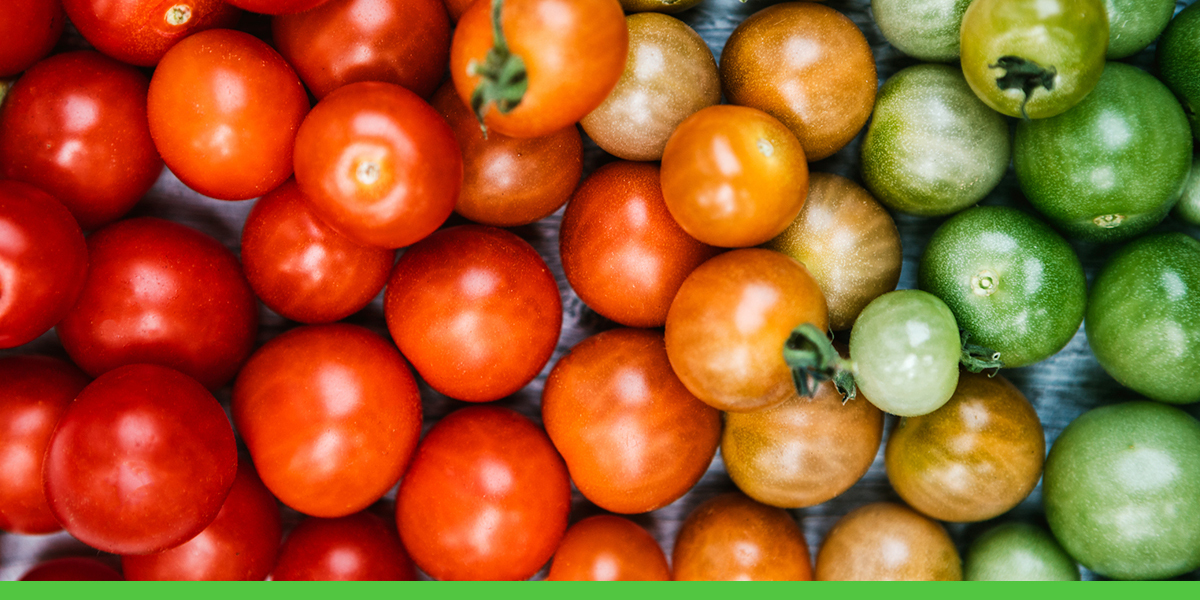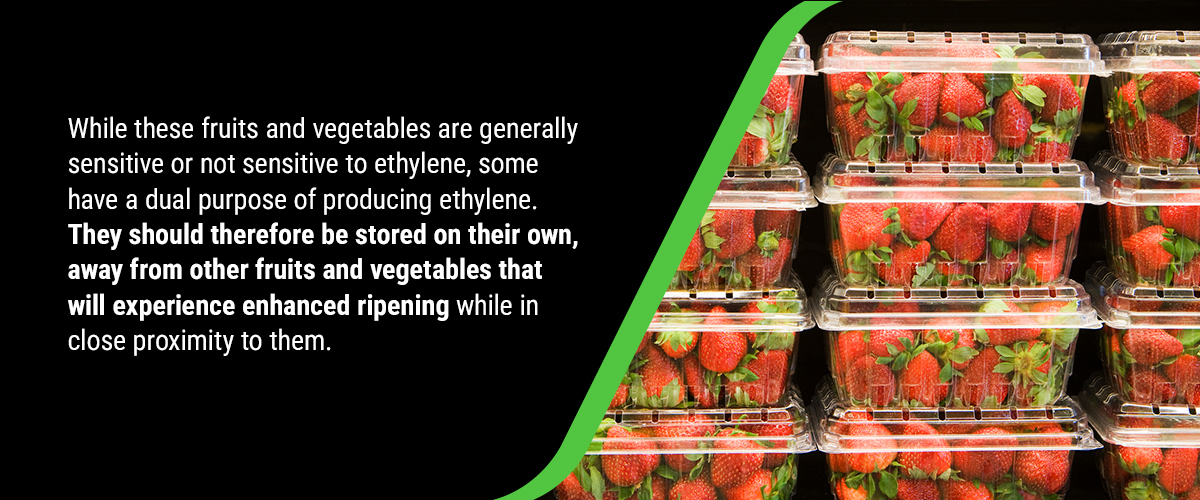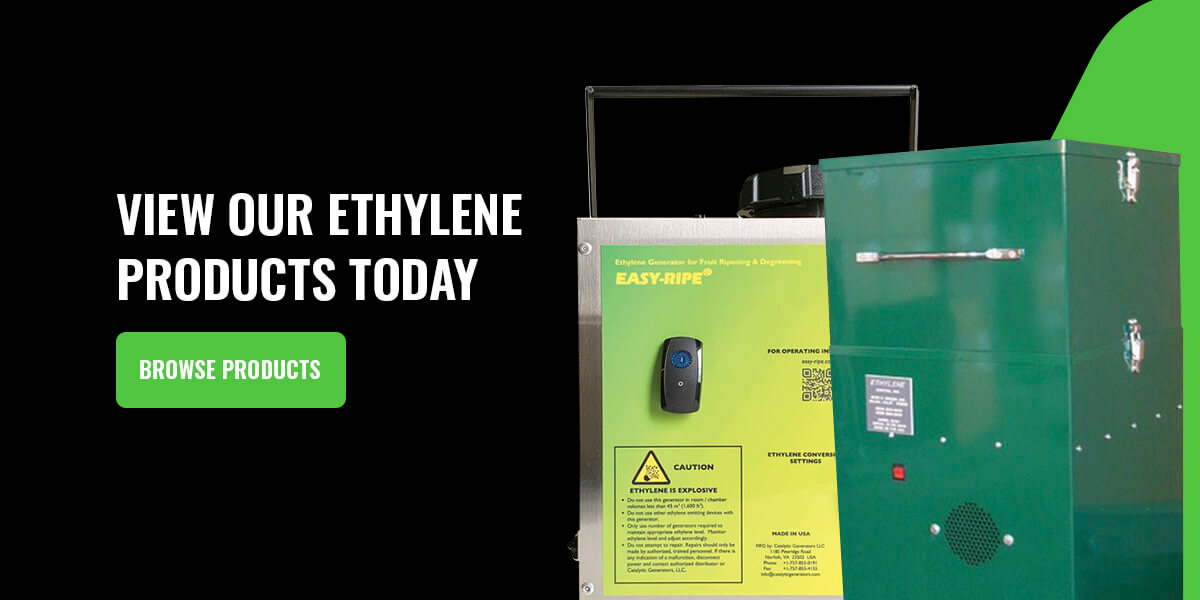How Does Ethylene Affect Fruit Ripening?
Aug 18th 2025

The fresh produce industry must ensure a balance between underripe and overripe fruit in the supply chain, from the time it's harvested to the point of purchase and consumption. That's where ethylene products come into play. Produced naturally in fruits and vegetables, this hormone is what causes them to ripen.
But what is ethylene, how does ethylene ripen fruit and how is it used in the supply chain?
The Role of Ethylene in Fruit Ripening
In plants, ethylene gas and fruit ripening share a close relationship. Ethylene promotes fruit ripening at a steady rate once it reaches maturity and encourages senescence, which is when cellular division stops, and the abscission of a plant's leaves. This is when they start detaching from the stem and can be picked. This natural process can be slowed by spraying signaling inhibitors that contain ethylene externally to preserve the longevity of cut plants.
Ethylene is important in the agricultural industry because its effects can be both suitable and damaging depending on the type of fruit, growth stage and levels of ethylene. Where one fruit lacks the concentration of ethylene to speed up ripening, placing it in a canister with fruit that contains high levels of ethylene will result in it ripening much quicker.
Farmers use methods that will reduce fruit spoilage before it's ready to be distributed to stores. For example, by using machines, they extract ethylene from fruit through a process called scrubbing. This helps slow down the ripening process in a cold storage facility. Similarly, they may induce ripening by spraying a liquid form of ethylene called ethephon over the fruit.
The Fruit Ethylene Production Process
Fruit undergoes different physiological changes during the ethylene gas ripening process. This includes the way it feels, tastes and looks. The obvious signs are softness, an increase in sweetness and a change in color from green to a brighter hue of orange, red or any other color that later signifies the type of fruit.
Ethylene gas encourages softness, which is usually the first sign of ripening. Softness is regulated when the cell walls of fruit that contain various types of sugar, like glucose and galactose, break down. Proteins or enzymes are responsible for breaking down the cell walls. These enzymes directly impact how long fruit lasts on shelves.
Sweet-tasting natural sugars like glucose, sucrose and fructose increase while starch decreases in fruit, enhancing its sweetness during ripening. Some fruits initially have no taste or start out bitter but get sweeter as they ripen, decreasing in acidity. At the peak of the ripening process, fruits produce composites that give them their distinct, pleasant smell. When fruit is overripe, the cell walls completely disintegrate, and the skin turns dark and moldy.
How Ethylene Gas Impacts Different Fruits
Ethylene levels in fruits are low at first but increase as they grow. Fruits are categorized by their tendency to ripen or not after harvest. Climacteric fruit ripens, while non-climacteric fruit doesn't ripen.
In climacteric fruit, ethylene production is autocatalytic. This means the initial production of small amounts of ethylene leads to an increase in production at a steady rate.
Non-climacteric fruit doesn't depend on ethylene for maturation. These fruits must be harvested after they've reached their optimal level of ripeness. Specific instruments measure the amount of ethylene that's produced in climacteric fruit to ensure the correct storage and handling processes are followed.
Ethylene-Sensitive (Climacteric) Fruit

Fruits that are sensitive to ethylene will ripen rapidly when exposed to other fruits that produce ethylene. For example, keeping apples and avocados in the fruit drawer in your fridge will likely result in both ripening within days, as they're ethylene-sensitive but produce ethylene at the same time.
Examples of ethylene-sensitive fruit and vegetables include:
- Apples
- Bananas
- Pears
- Avocados
- Cucumber
- Grapes
- Lemons
- Lettuce
- Mangoes
- Kiwi
- Onions
- Sweet potatoes
- Squash
- Broccoli
- Eggplant
Fruit Not Sensitive to Ethylene (Non-Climacteric)
In comparison, certain fruit ripens at a slow or normal rate regardless of exposure to ethylene. These fruits tend to have longer shelf lives after being picked and harvested for personal or commercial consumption.
Examples of fruit and vegetables that aren't sensitive to ethylene include:
- Strawberries
- Raspberries
- Blueberries
- Cherries
- Oranges
- Pineapple
- Grapefruit
- Tomatoes
- Potatoes
- Garlic
- Beans
While these fruits and vegetables are generally sensitive or not sensitive to ethylene, some have a dual purpose of producing ethylene. They should therefore be stored on their own, away from other fruits and vegetables that will experience enhanced ripening while in close proximity to them.
Examples of ethylene producers include:
- Apples
- Bananas
- Pears
- Avocados
- Peaches
- Kiwi
- Peppers
- Tomatoes
Feedback Loops in Biology
A feedback loop is an organic system in which the results of an output or effect will either magnify or impede the system. Homeostasis has everything to do with feedback loops in biology and nature. Because homeostasis aims to maintain consistent internal conditions, any change in this condition is combated by a feedback loop that will try to get it back to that same consistency.
Body temperature is a good example. If your body experiences a rise in temperature, your blood flow will increase, and you'll feel your skin get warm to the touch. To get it back to a regulated state, you'll start sweating, and your skin will start cooling. In this instance, the hypothalamus acts as the feedback loop that initiates responses to bring your body temperature back to normal.

The Impact of Feedback Loops on Fruit Ripening and Quality
Feedback loops in nature can be positive or negative. In fruit ripening, a positive fruit ripening feedback loop is observed whereby one result impacts the system by multiplying the same result. In other words, one apple on a tree contains enough ethylene to ripen it, which in turn produces more ethylene to ripen the surrounding apples on the tree.
A feedback loop doesn't yield positive results in the sense of the word. It often lacks the ability to counter a process or may cause a chain reaction. As mentioned, this is the case with ethylene distribution on an apple tree, where every apple is impacted until they're all ripe and fall off — if they're not harvested in time.
There's no stopping this process, and great loss is usually incurred due to the progression and speed of the ripening process. The quality of fruit is significantly affected by the rate at which it deteriorates unless it's harvested in time.
Ethylene Monitoring and Control Systems
Ripening rooms need to be kept under specific conditions, carefully monitored and controlled, to ensure fruit ripens exactly when planned.
Monitoring
Several conditions need to be monitored, including:
- Ethylene levels: Ethylene testing instruments can accurately measure ethylene levels in any ripening room.
- Temperature and humidity: A simple temperature and humidity logger, which automatically records measurements, can be used to monitor both temperature and humidity.
- Oxygen: An oxygen gas detector makes it easy to monitor oxygen levels.
- Carbon dioxide: Measuring carbon dioxide levels is simple with a preferred carbon dioxide tester.
There are also tools specifically designed to monitor ripening rooms, such as the F-960 Ripen It! Gas Analyzer, which simultaneously tests for ethylene, oxygen and carbon dioxide levels.
Beyond monitoring the storage conditions, the fruits themselves also need to be tested. To effectively monitor ripeness, tools like the Baxlo Fruit Firmness Tester can determine firmness levels in fruits such as blueberries, grapes and strawberries.
Control
If any of these conditions stray outside of the desired range, it's important that they're brought back under control.
If there's too much carbon dioxide or not enough oxygen, carefully increasing the ventilation of the ripening room can create balance. Carbon dioxide levels can also be lowered by using specialized scrubbers or placing bags of calcium carbonate in the ripening room. Additionally, too much oxygen can be remedied by nitrogen flushing, and introducing more carbon dioxide will increase levels when they're too low.
Ethylene levels are also easy to reduce in a ripening room thanks to various ethylene removal systems, such as ethylene filters. Finally, humidity controllers can control the humidity in the ripening room.
Having this level of control over ripening helps farmers extend shelf life, decrease decay and provide fruit out of season when there's still a demand.
Optimal Storage Conditions by Fruit Type
The ripening process of a climacteric fruit can be slowed to the desired rate based on the ethylene levels, among other conditions. To keep ethylene levels below the optimal level of 1 ppm, it's important that these other conditions are kept within the desired ranges. These ranges will vary depending on the fruit:
- Apples: To most effectively slow the ripening process, apples should be kept in temperatures between -1°C and 4°C (30.2°F to 39.2°F), and at a humidity between 90%-95%. This will give a storage life of between 30 and 180 days.
- Avocados: Avocados require temperatures of 3-13°C (37.4°F to 55.4°F). At a humidity of 85%-90%, the expected storage life is between 14 and 56 days.
- Bananas: Also optimally stored at a humidity between 90%-95%, bananas are best stored at warmer temperatures of 13-15°C (55.4°F to 59°F). In these conditions, storage life will be between seven and 28 days.
- Lemons: Lemons are best stored at temperatures of 10-13°C (50°F to 55.4°F) and at a humidity of 85%-90%. In these conditions, the expected storage life is 30-180 days.
- Mangoes: Storage life for mangoes is between 14 and 21 days if stored at 13°C (55.4°F) with a humidity of 90%-95%.
- Pears: To enjoy the maximum storage life of 60-210 days, pears should be kept at 90%-95% humidity and at a temperature of between -1.5°C and 0.5°C (29.3°F to 32.9°F).
Gas chromatography measures the concentration of ethylene in fruit using a syringe, which helps determine the rate at which it can be anticipated to ripen. Ethylene gas, scrubbers, air sanitization and filtration systems, and storage units are used to regulate ripening during storage and transport and extend the fruit's shelf life.
Storage Methods
There are different ways to store fruit and vegetables. Each has different results, based on the type of fruit or vegetable and how long it needs to be stored.
- Cold storage: This includes the use of refrigerated or freezer storage warehouses or facilities for private or public use. Cold storage includes mobile containers and blast freezers that are helpful for keeping produce cold between harvesting and transportation to the shelf.
- Multi-commodity cold storage: Similar to warehouse cold storage, this type of storage keeps a variety of commodities fresh in a constant, controlled environment where they can be removed at any point in time.
- Controlled atmosphere storage: Fresh produce is kept in optimal condition post-harvest for longer periods by increasing carbon dioxide and reducing oxygen in a storage container. This is achieved through consistent monitoring and by adjusting these gas levels.
Transportation
Regardless of the distance traveled from harvest to distribution, fruit must be packaged appropriately to ensure it doesn't release ethylene in confined spaces in transit. Using mobile transport units or trucks with coolers ensures fruit stays at a cool temperature, which aids in decreasing ethylene release.
Shelf Life
Once fruit hits the shelf, it needs to be maintained using filters or sachets that absorb the ethylene to keep it on the shelf for longer. In most cases, fruit is sprayed with a light mist and kept at a cool temperature on the shelf as an extra preservation measure. A lack of these systems will lead to fruit decaying at a faster rate, and these products have to be thrown away before they're purchased, leading to profit losses on a large scale.
View Our Ethylene Products Today
If you're looking for ways to keep your fresh produce in the best condition before it's sent for storage, packaging or distribution, QA Supplies can help by providing quality ethylene ripening tools and removal systems. Additionally, we offer everything from quality inspection instruments and harvesting tools to food analysis and pest control equipment from a wide range of brands.
Call us toll-free to get in touch or request a catalog of all our products and brands today.


